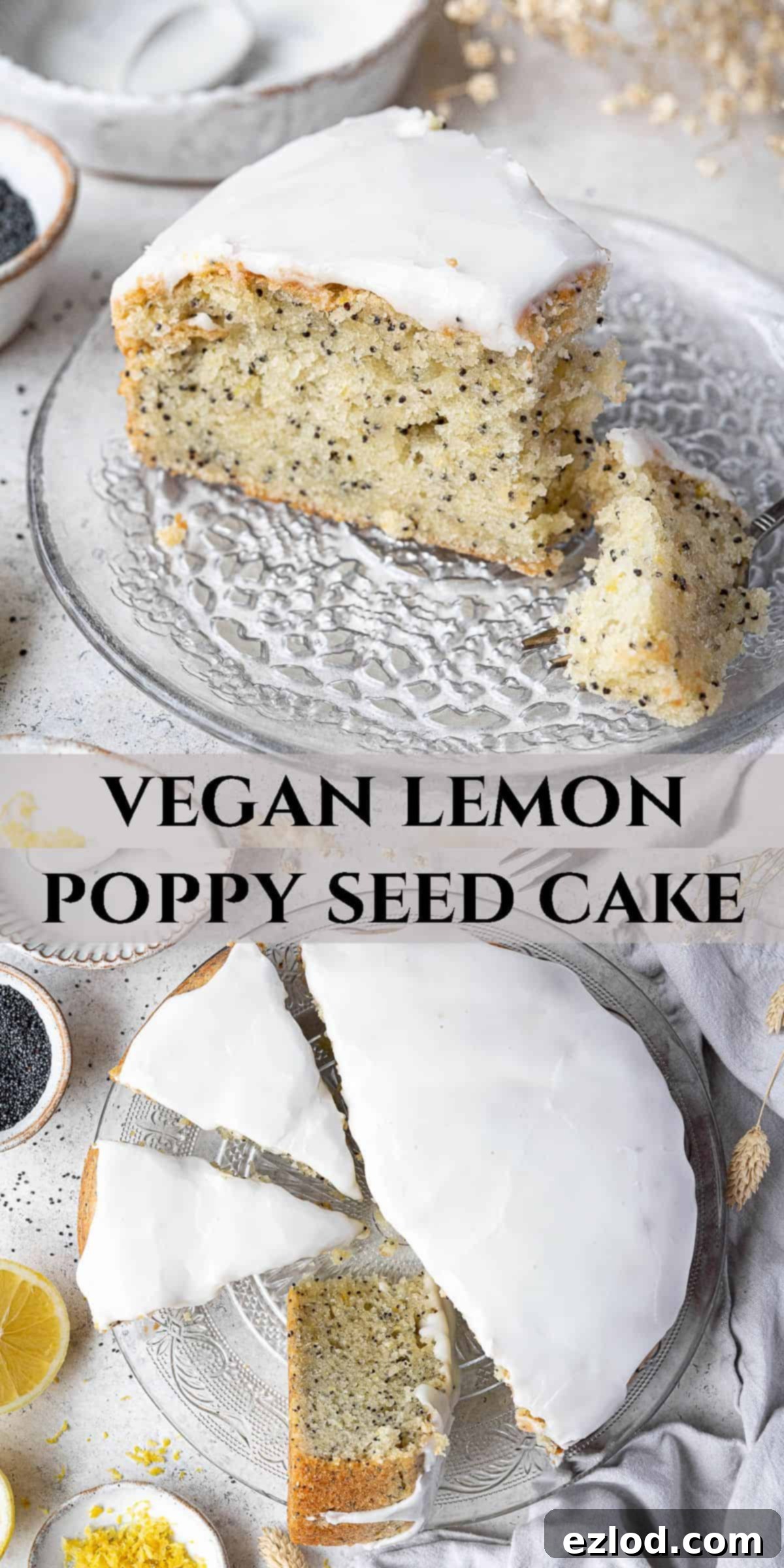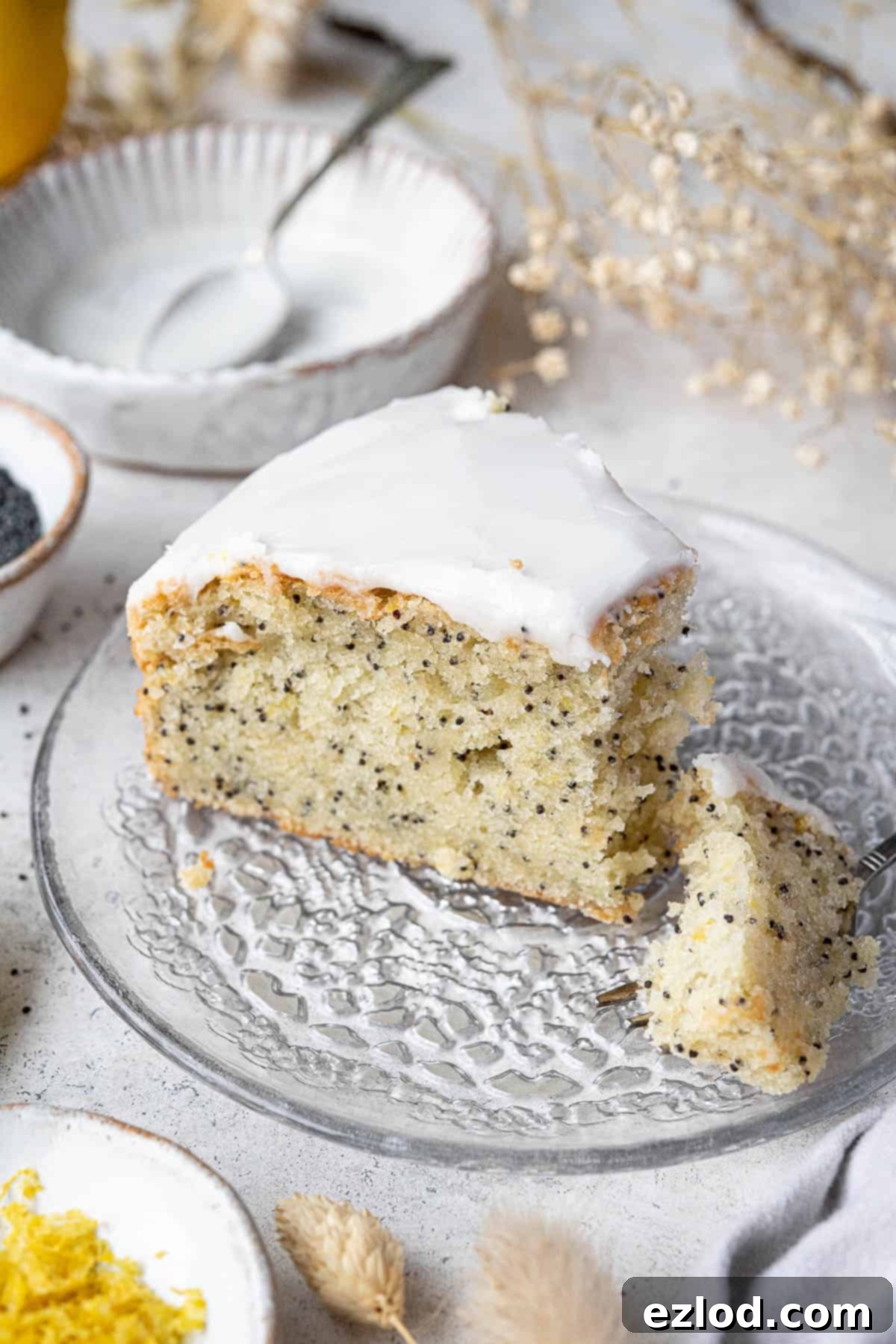The Ultimate Guide: How to Bake a Perfectly Moist & Zesty Vegan Lemon Poppy Seed Cake
Discover the secret to a truly exceptional vegan lemon poppy seed cake! This delightful dessert boasts an incredibly moist, light, and fluffy texture, bursting with a fresh, vibrant, and zesty lemon flavor that will tantalize your taste buds.
Effortlessly easy to prepare, this cake is versatile enough to be the star of any celebration or a wonderful treat to brighten up an ordinary week. Its simple elegance and irresistible taste make it a go-to recipe for any occasion, from festive gatherings to cozy afternoon tea.
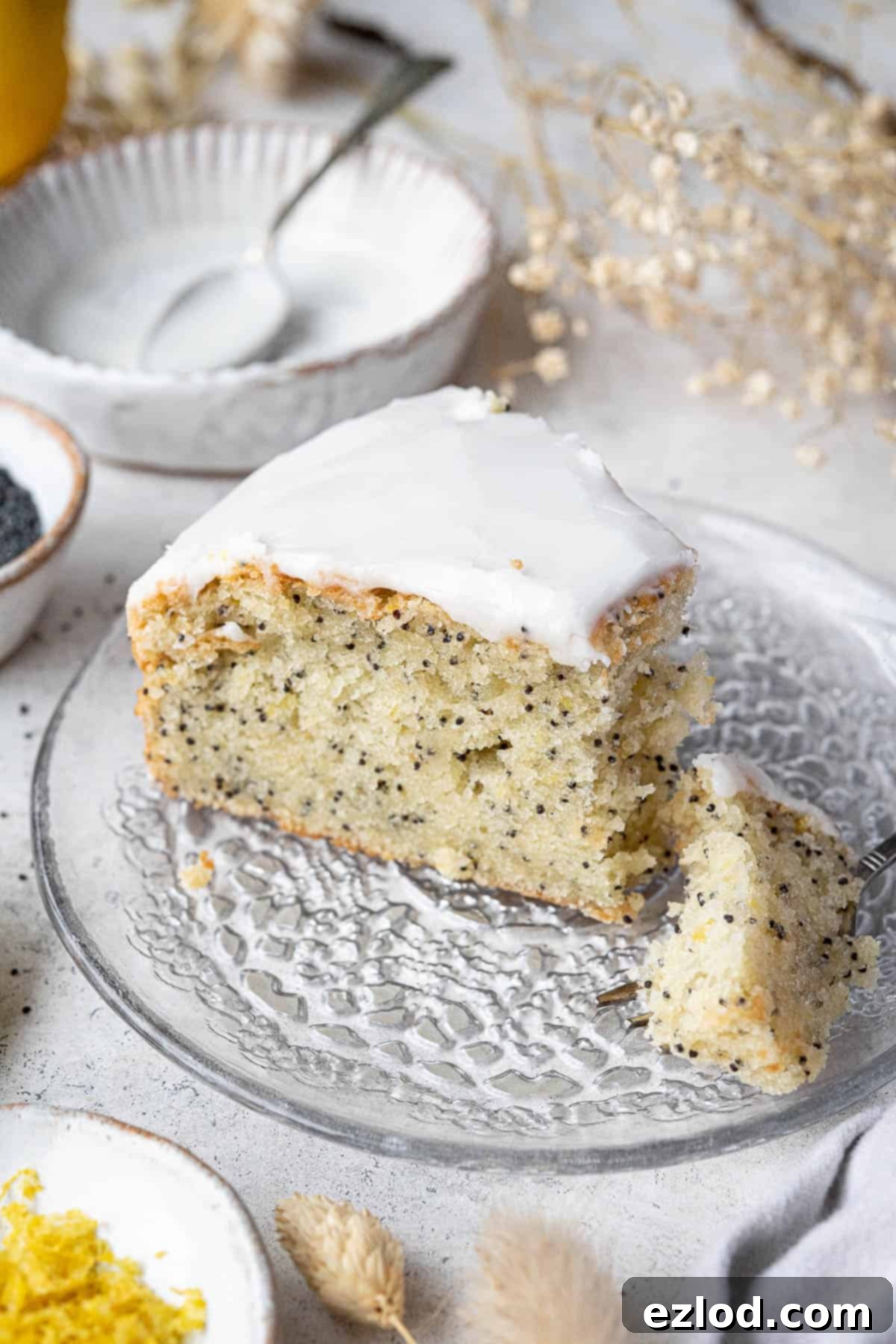
This vegan lemon poppy seed cake is a true masterpiece of plant-based baking. Each bite offers a beautifully soft and moist crumb, infused with a delicate yet distinct zesty lemon flavor. To further amplify that citrusy punch, we top it with a simple, tangy lemon glaze, creating a perfect balance of sweet and tart. The addition of poppy seeds isn’t just for aesthetics; they contribute a wonderful, subtle texture and a slight nutty note that complements the bright lemon beautifully.
The journey to perfecting this recipe involved careful adaptation and thoughtful adjustments from my beloved vegan lemon pound cake. While the pound cake is fantastic in its own right, I aimed for a slightly lighter, fluffier texture for this version, making it even more ethereal. This transformation was achieved by swapping out silken tofu for a plant-based yogurt, which introduces more moisture and a lovely tang without adding heaviness. A clever blend of vegan block butter and neutral oil ensures both richness and an incredibly moist crumb. Furthermore, replacing some of the plain flour with cornflour (cornstarch) contributes to that desired delicate, tender texture. Instead of relying solely on self-raising flour, I opted for a combination of plain flour, baking powder, and bicarbonate of soda (baking soda), offering greater control over the cake’s rise and structure. I also boosted the lemon content slightly for an even more vibrant flavor and subtly reduced the sugar, allowing the natural brightness of the lemon to truly shine. Finally, baking it in a round tin rather than a loaf pan provides a classic cake aesthetic, perfect for slicing and serving at any gathering.
This lemon poppy seed cake is not just a treat for special occasions; its simplicity and satisfying nature make it an ideal everyday indulgence. Imagine a slice with your morning coffee or as an afternoon pick-me-up. However, its elegant appearance and refreshing flavor also make it a standout choice for celebrations, particularly fitting for spring festivities like Easter or Mother’s Day, where bright, fresh flavors are always appreciated. It’s truly a cake that offers the best of both worlds – easy to make, yet impressive enough to share.
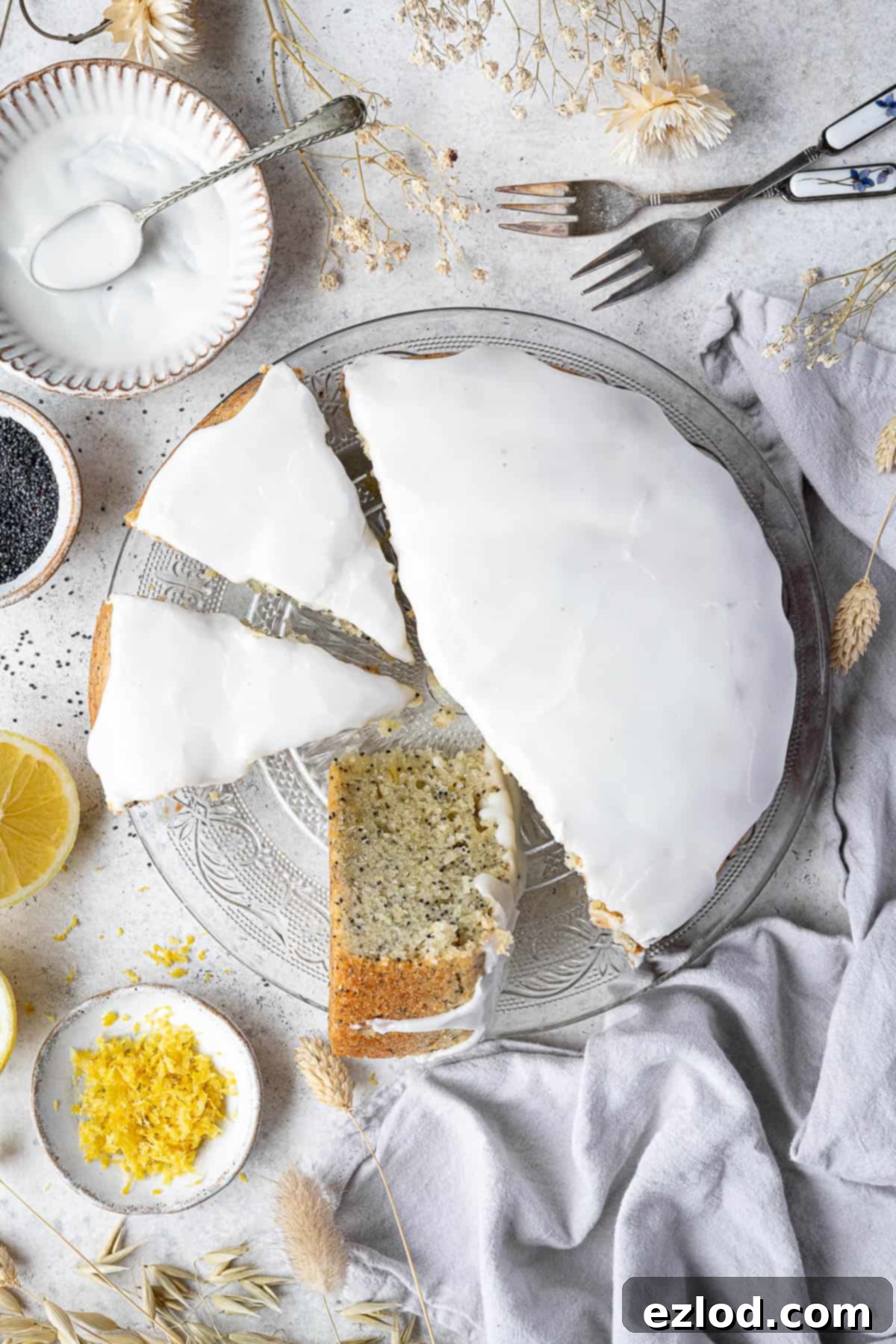
Essential Ingredients for Your Vegan Lemon Poppy Seed Cake:
Crafting the perfect vegan lemon poppy seed cake starts with understanding the role each ingredient plays. Here’s a detailed look at what you’ll need and why specific choices are recommended for the best results:
Fresh Lemons
Lemons: You’ll require both the finely grated zest and fresh juice from lemons. It is absolutely crucial to buy unwaxed lemons for this recipe, as the zest from waxed lemons can carry unwanted chemicals and interfere with the pure lemon flavor we’re aiming for. The zest contains concentrated lemon oils, providing the most intense aroma and flavor, while the juice adds a bright acidity that activates our leavening agents and keeps the cake moist.
Plant-Based Yogurt
Yogurt: Plant-based yogurt is a true hero in vegan baking, especially in cakes. It acts as an excellent egg replacer, contributing moisture, tenderness, and a subtle tang that enhances the lemon flavor. For optimal results, plain, unsweetened soy yogurt is highly recommended due to its consistent texture and protein content, which aids in structure. However, plain unsweetened coconut or oat-based yogurts can also be used; just be aware they might impart a very slight variation in flavor or texture. Avoid sweetened or flavored yogurts as they will alter the sugar balance and overall taste of the cake.
Non-Dairy Milk
Milk: Any unsweetened non-dairy milk can be used, but unsweetened soy milk is generally preferred. Its higher protein content compared to other plant milks can contribute to a slightly more stable and moist cake structure. Other options like almond or oat milk will also work, but always ensure they are unsweetened to maintain control over the cake’s sweetness. The milk helps hydrate the flour and bring the batter to the right consistency.
The Fat Duo: Vegan Butter and Oil
Butter and oil: This recipe wisely incorporates both vegan block butter and a neutral oil to achieve the ultimate cake texture. Vegan block butter provides a rich, buttery flavor and contributes to the cake’s structure, much like dairy butter would in traditional baking. For the best structural integrity and flavor, always opt for a firm vegan block butter rather than a soft, spreadable tub variety. Brands like Naturli Vegan Block or Flora Plant B+tter are excellent choices. The oil, on the other hand, is key for making the cake incredibly moist and tender, as it remains liquid at room temperature, preventing a dry crumb. I typically use light olive oil, but any neutral-flavored oil such as canola, sunflower, or grapeseed oil will work perfectly without imparting any dominant flavors of its own.
Sweeteners
Sugar: Caster sugar (superfine granulated sugar) or regular granulated sugar are the best choices for this cake. Their fine crystals dissolve easily into the batter, ensuring an even sweetness and contributing to a fine crumb. It’s important to avoid substitutions like brown sugar, liquid sweeteners (e.g., maple syrup, agave), or artificial sweeteners, as these will significantly alter the cake’s texture, moisture content, and overall baking chemistry. For the vibrant lemon glaze, you will also need fine icing sugar (powdered sugar), which dissolves smoothly to create that perfect pourable consistency.
Flour & Starches
Plain flour: Plain all-purpose flour forms the backbone of our cake. It provides the necessary structure without being overly dense. While this recipe hasn’t been extensively tested with gluten-free alternatives, a good quality plain gluten-free flour blend combined with about ¼ teaspoon of xanthan gum (which helps mimic gluten’s binding properties) should yield acceptable results. Be aware that GF cakes can sometimes be slightly denser or have a different crumb structure.
Cornflour: Adding a small amount of cornflour (cornstarch) is a fantastic trick to achieve a truly lovely, light, and tender texture in cakes. It reduces the overall gluten development, resulting in a more delicate crumb that melts in your mouth. If you don’t have cornflour on hand, you can substitute it with an equal amount of additional plain flour, but the cake’s texture will be slightly less delicate.
Leavening Agents
Baking powder and soda: This recipe utilizes both baking powder and bicarbonate of soda (baking soda) for a reason. Baking soda reacts with the acidic ingredients (lemon juice, yogurt) to create carbon dioxide, contributing to the cake’s lift and tenderness. Baking powder, often a double-acting agent, provides an initial lift when wet ingredients are mixed and a secondary lift during baking. Using both ensures an optimal rise and a beautifully airy texture. It’s crucial not to swap one for the other or omit either, as they function differently and are essential for the intended result.
Poppy Seeds
Poppy seeds: These tiny seeds are not just for show; they add a delightful, subtle nutty flavor and a distinctive, pleasant texture to the cake, creating a wonderful contrast to the soft crumb. While you can technically omit them for a plain lemon cake, they are highly recommended for the classic lemon poppy seed experience. Ensure your poppy seeds are fresh for the best flavor.
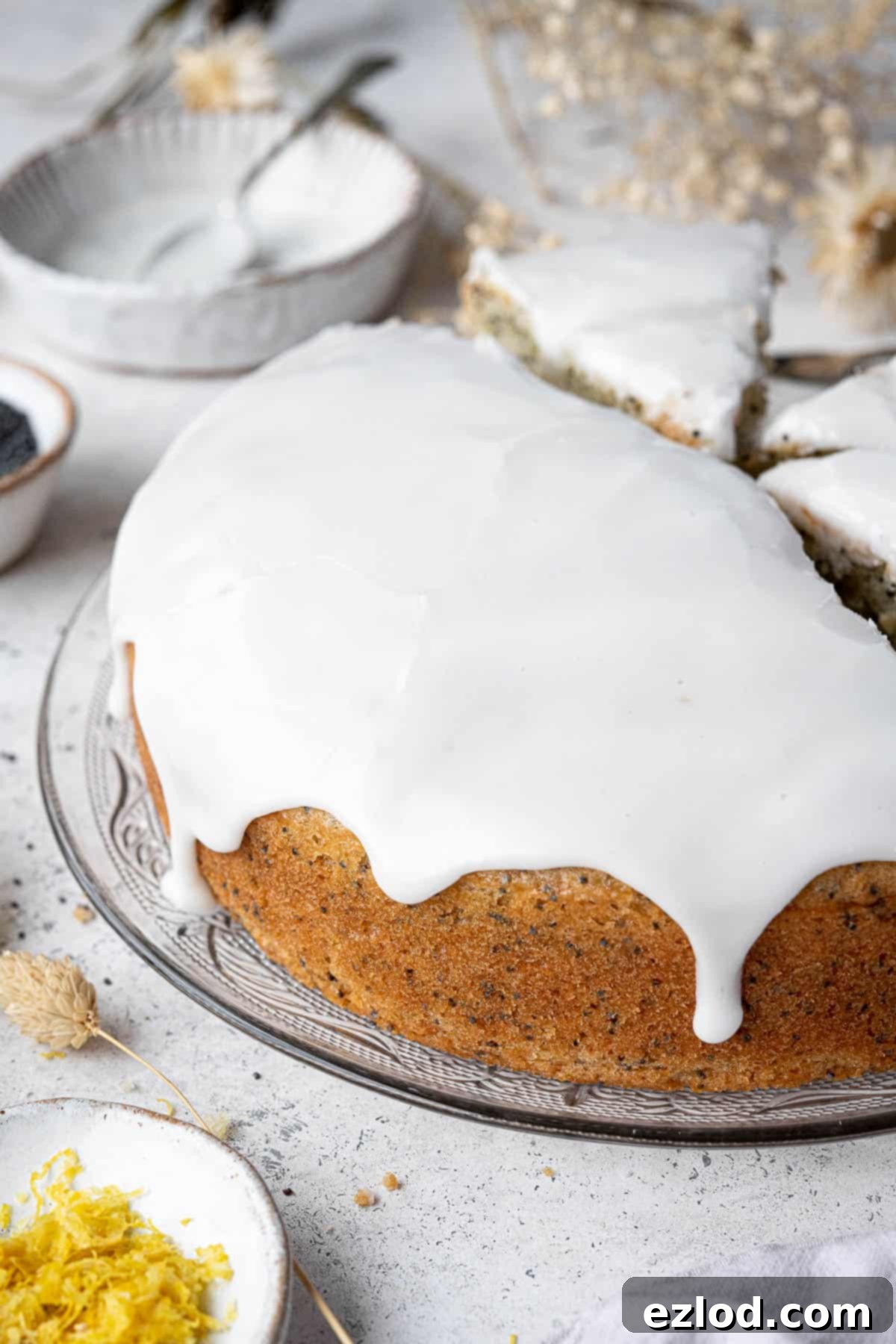
How To Bake Your Delicious Vegan Lemon Poppy Seed Cake:
(Full detailed measurements and precise instructions can be found in the comprehensive recipe card located at the very bottom of this page. These steps provide an overview to guide you through the process.)
1. Prepare Your Dry Ingredients
Begin by sifting together the plain flour, cornflour, baking powder, bicarbonate of soda, and a pinch of salt into a large mixing bowl. Sifting is an important step as it aerates the flour, prevents lumps, and ensures that your leavening agents are evenly distributed throughout the dry mixture, leading to a consistent rise and texture in your finished cake.
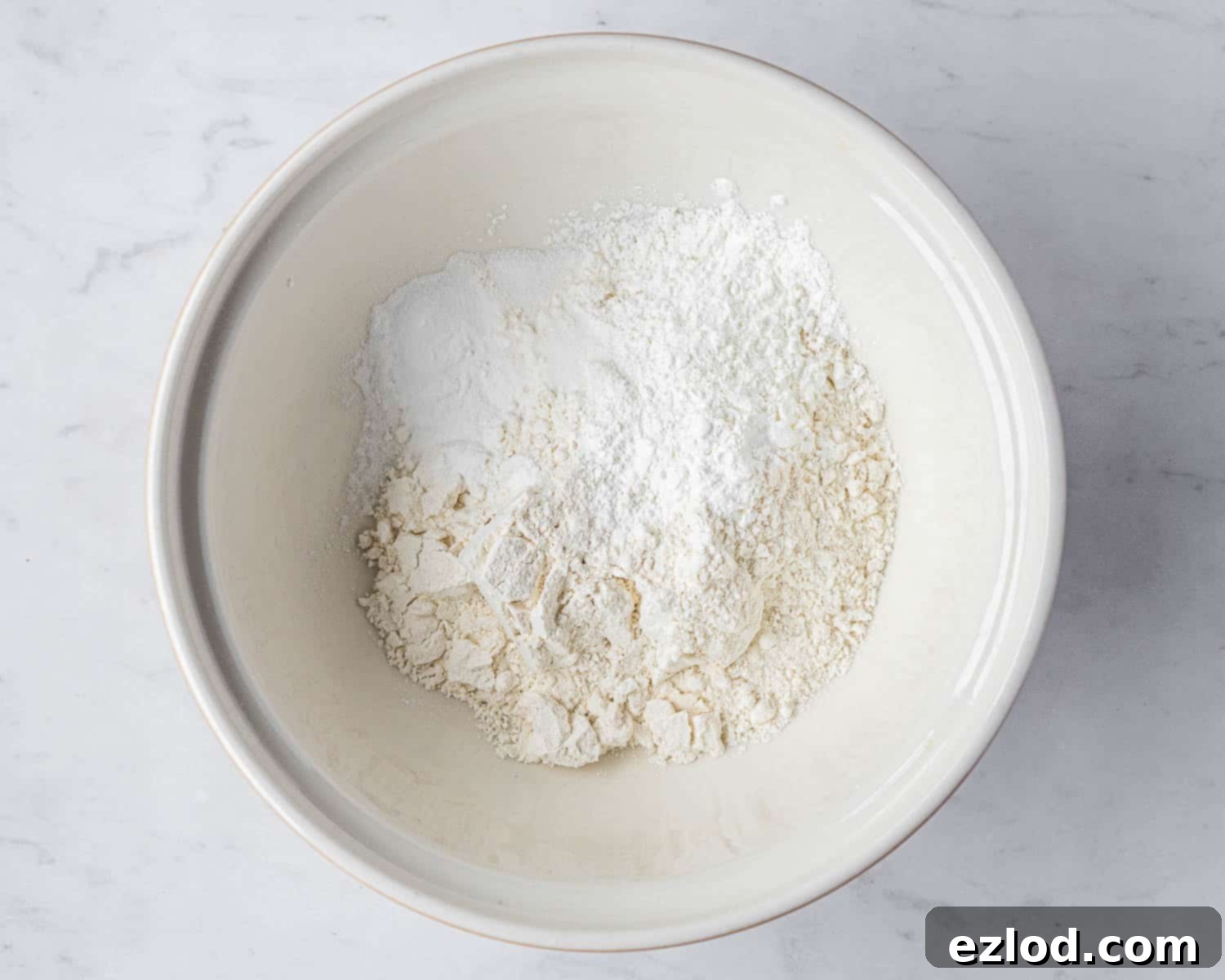
2. Combine Wet Ingredients
In a separate jug or medium bowl, whisk together the fresh lemon zest, lemon juice, melted vegan block butter, neutral oil, unsweetened plant-based yogurt, and unsweetened non-dairy milk. Whisk thoroughly until all the wet ingredients are well combined and appear homogenous. Ensure your melted butter has cooled slightly before adding it to avoid cooking the yogurt or milk.
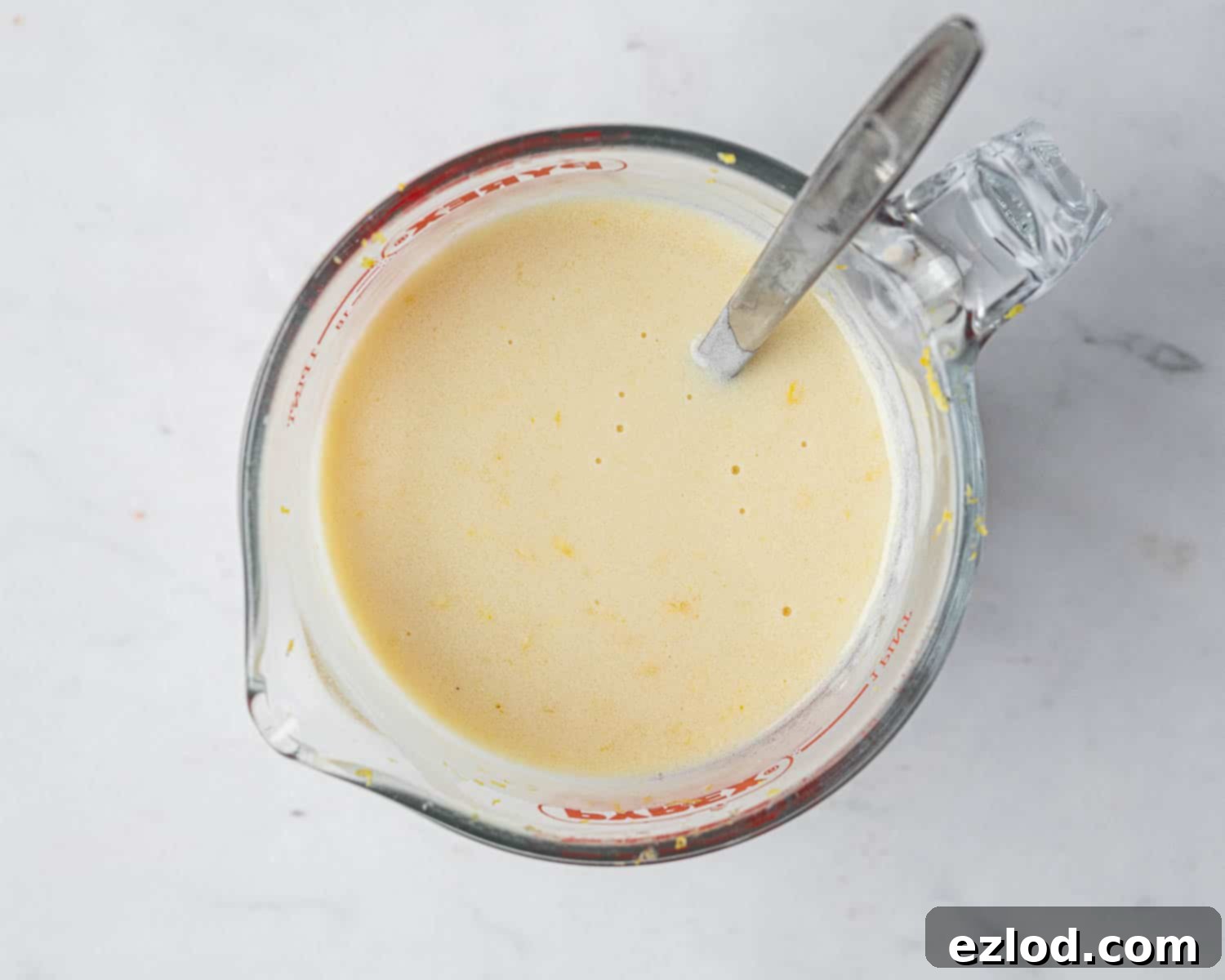
3. Mix Batter & Add Poppy Seeds
Pour the combined wet ingredients into the large bowl with your dry ingredients. Add the caster or granulated sugar to this mixture. Using a balloon whisk, gently stir the ingredients until they are just combined and no dry lumps of flour remain. Be careful not to over-mix, as this can develop the gluten in the flour too much, leading to a tough cake. Once the batter is smooth, gently fold in the poppy seeds using a spatula or spoon, ensuring they are evenly distributed without crushing them.
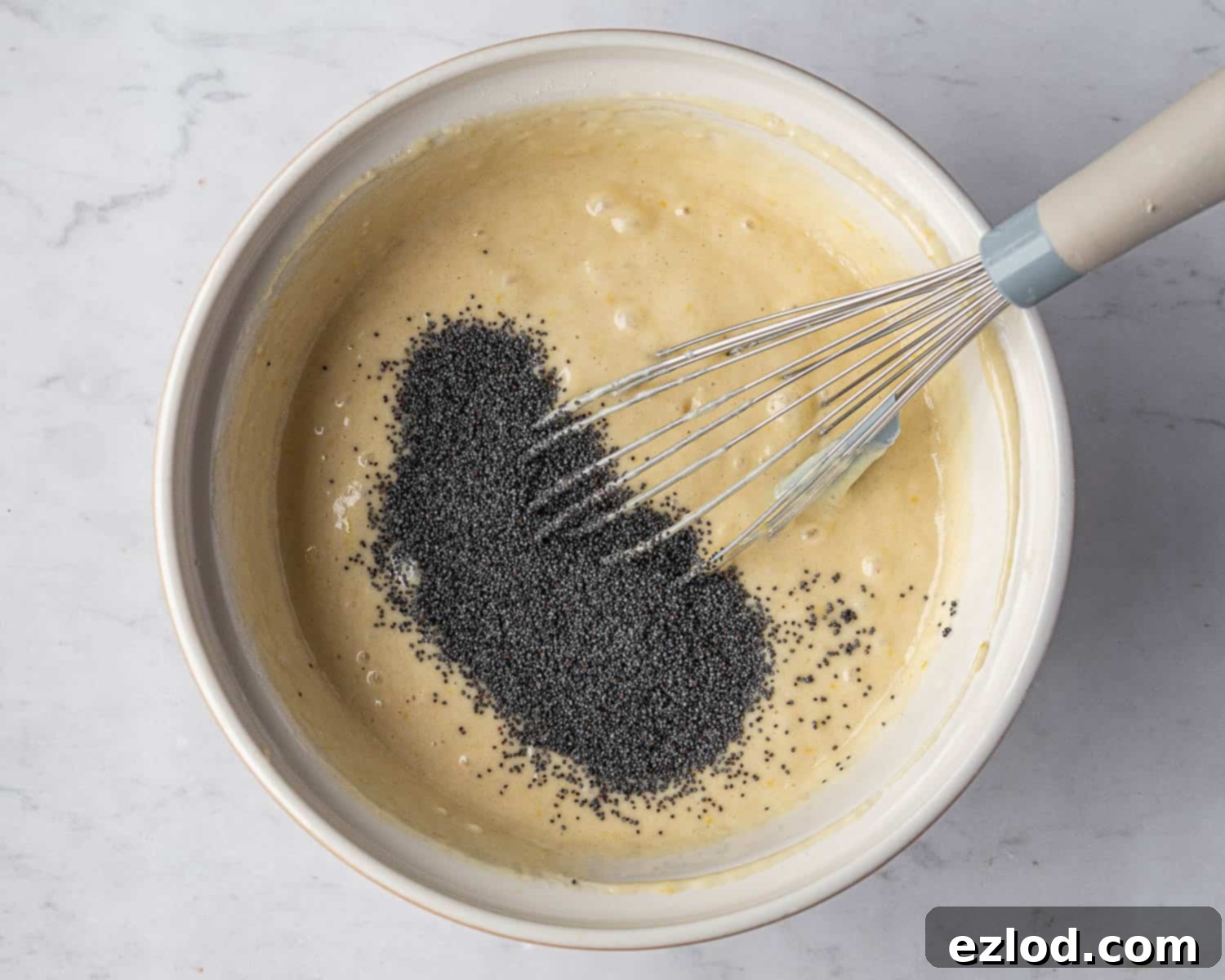
4. Prepare for Baking
Carefully pour the prepared batter into your greased and parchment-lined 20 cm (8 inch) round cake tin. Gently spread the batter evenly across the tin using the back of a spoon or a small offset spatula to ensure an even rise during baking.
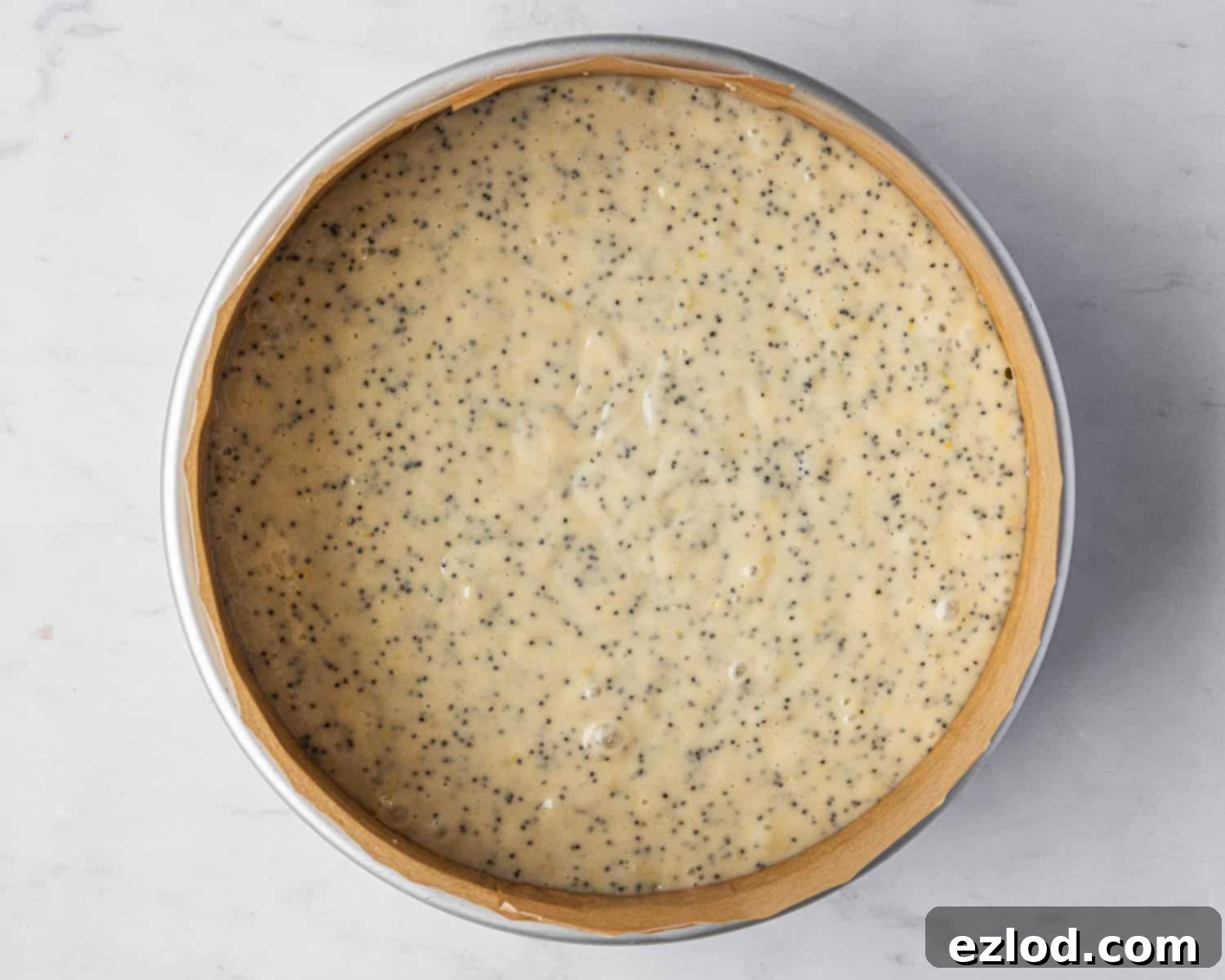
5. Bake to Perfection
Bake the cake in your preheated oven for approximately 45-50 minutes. The cake is done when it’s golden brown on top, springs back gently when lightly pressed, and a wooden skewer or toothpick inserted into the center comes out clean or with only a few moist crumbs attached. Avoid opening the oven door too frequently during the first 30 minutes of baking to prevent the cake from sinking. Once baked, let the cake cool in the tin for about 20 minutes before carefully inverting it onto a wire rack to cool completely. This resting period helps the cake set and prevents it from breaking.
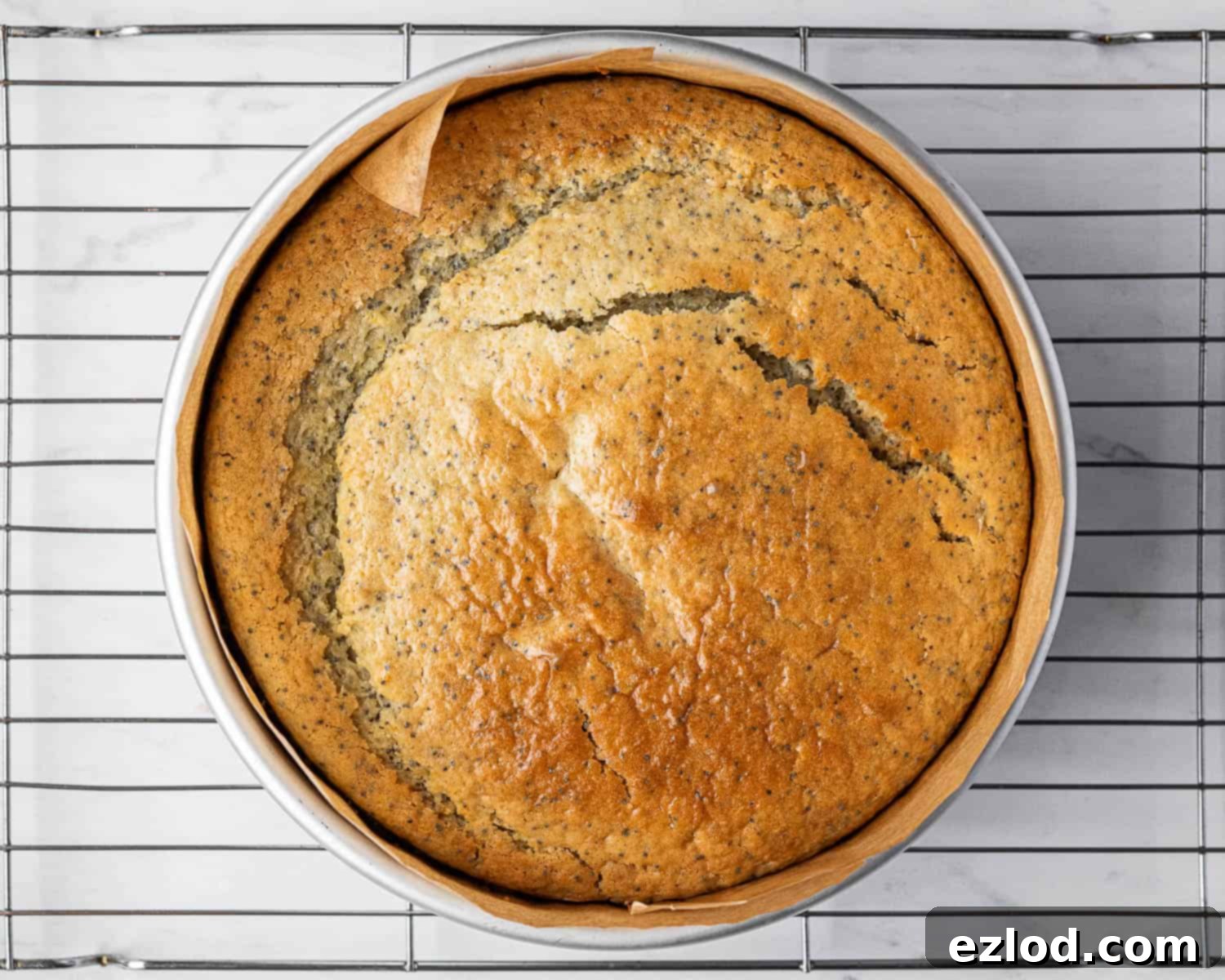
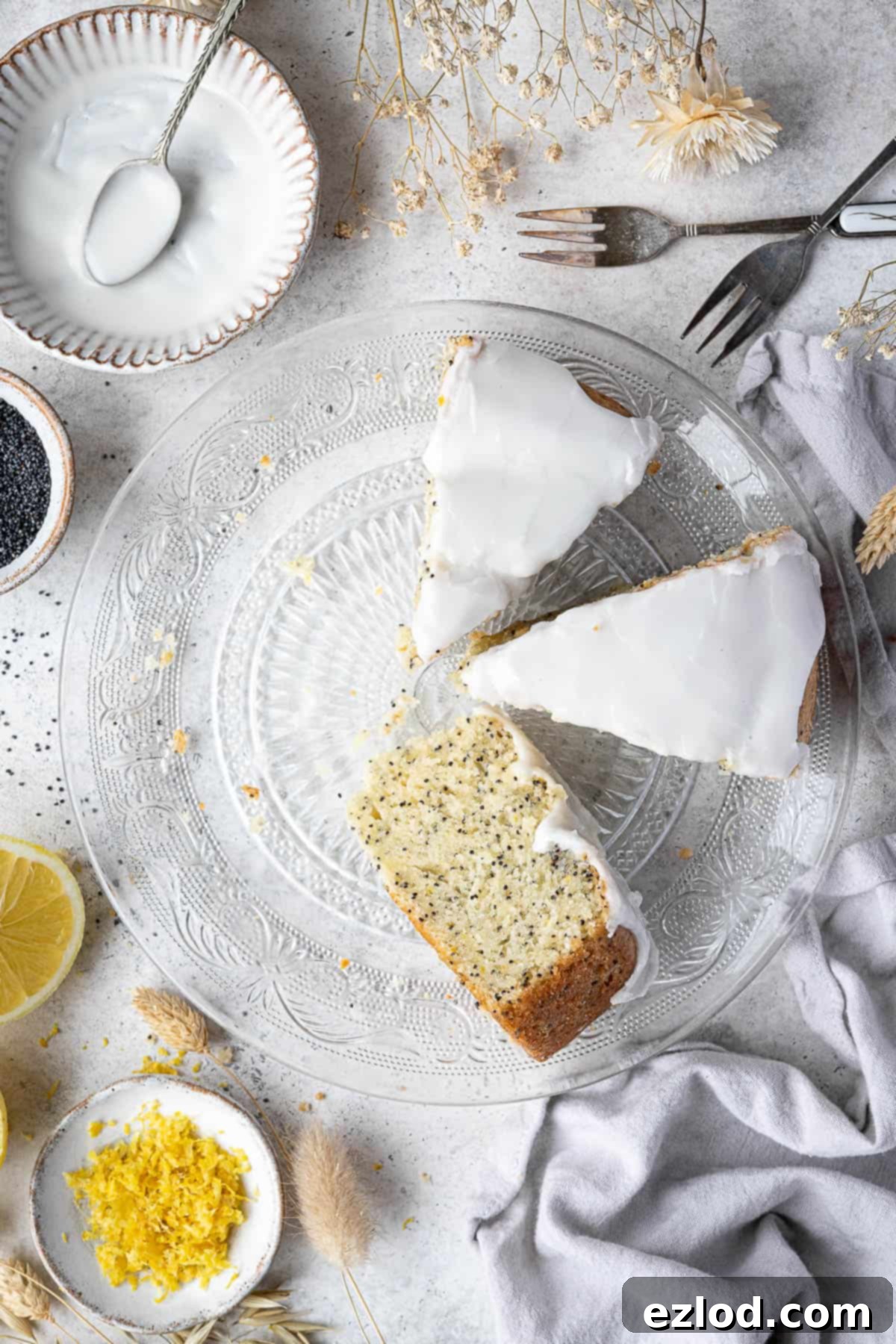
Expert Tips for a Flawless Vegan Lemon Poppy Seed Cake:
Achieving baking perfection often comes down to a few key details. Here are some expert tips to ensure your vegan lemon poppy seed cake turns out beautifully every single time:
- Precision in Measurement: As with all my baking recipes, I cannot stress enough the importance of using metric measurements with a digital scale rather than cup conversions. Cups are notoriously inaccurate and inconsistent, leading to varied results. A digital scale ensures precise ingredient ratios, giving you far better, more consistent outcomes. Plus, weighing ingredients is often quicker and creates less mess than using multiple measuring cups!
- Unwaxed Lemons are Key: Always make sure you buy unwaxed lemons. The wax coating found on many lemons is not typically vegan and is certainly not something you want to be grating into your cake. Unwaxed lemons ensure a pure, clean lemon zest flavor without any unwelcome chemicals.
- Don’t Over-Mix Your Batter: This is a golden rule in baking, especially for cakes. Over-beating the batter develops the gluten in the flour too much, which can result in a dense, tough, or rubbery cake. Mix only until the ingredients are just combined and no dry streaks of flour remain. A few small lumps are perfectly fine and often preferable to an over-mixed batter.
- How to Tell Your Cake is Done: The cake is ready when it is firm to the touch, and a wooden skewer or toothpick inserted into the very center comes out clean. A few moist crumbs clinging to the skewer are acceptable, indicating a perfectly moist cake, but no wet batter should be present. The top should also be golden brown and spring back when gently pressed.
- Optimal Storage: While the cake’s texture is often at its fluffiest and most delightful on the day it’s baked, it will remain wonderfully fresh and moist for approximately 3-4 days when stored in an airtight container at room temperature. Keeping it sealed helps retain its moisture and prevents it from drying out.
- Freezing for Later Enjoyment: This cake freezes exceptionally well! Once completely cooled, wrap the cake tightly in at least two layers of cling film (plastic wrap) and then a layer of aluminum foil to protect it from freezer burn. It can be frozen for up to 2-3 months. To thaw, simply remove it from the freezer and let it come to room temperature while still wrapped, which helps retain moisture.
- Room Temperature Ingredients: For the best emulsion and a smooth, consistent batter, try to bring your wet ingredients like plant-based yogurt and non-dairy milk to room temperature before mixing. This helps them combine more evenly with the melted butter and oil, resulting in a more cohesive batter and a better-textured cake.
- Zesting Technique: When zesting your lemons, use a microplane grater and only remove the bright yellow outer layer. Avoid the white pith directly underneath, as it can be quite bitter and detract from the fresh lemon flavor.
Explore More Vegan Lemon Recipes:
- Luscious Vegan Lemon Curd
- Refreshing Vegan Lemon Ice Cream
- Zesty Lemon Blueberry Polenta Cake
- Classic Vegan Lemon Drizzle Cake
- Elegant Vegan Lemon Tart
- Hearty Vegan Lemon Pound Cake
- Sweet & Tangy Vegan Lemon Bars
- Soft Vegan Lemon Blueberry Rolls
- Delicate Vegan Lemon Sandwich Cookies
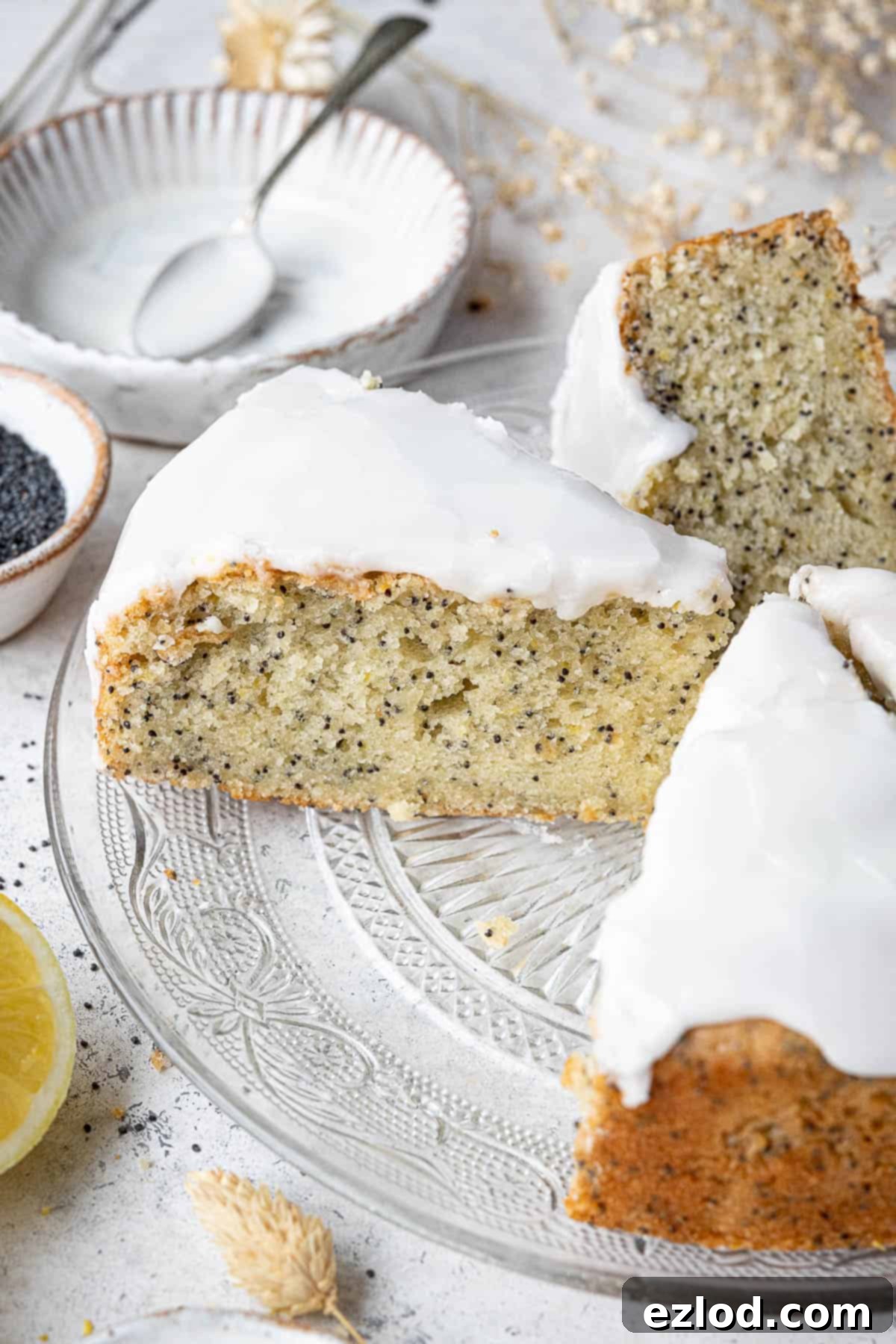
If you’ve had the pleasure of trying this exquisite vegan lemon poppy seed cake recipe, I would love to hear from you! Please consider rating it, leaving a comment below to share your experience, or tag @domestic_gothess on Instagram and use the hashtag #domesticgothess. Your feedback is truly appreciated!
All images and content on Domestic Gothess are copyright protected. If you wish to share this recipe with others, please do so by utilizing the provided share buttons. We kindly request that you do not screenshot or post the recipe or content in its entirety. Instead, please include a direct link to this post for the full recipe details. Thank you for respecting our work!

Vegan Lemon Poppy Seed Cake
Course
Dessert
Cuisine
British
Keyword
cake
Prep Time
15 minutes
Cook Time
45 minutes
Servings
10
people
Author
Domestic Gothess
Ingredients
Cake:
-
250
g (2 cups)
plain (all-purpose) flour -
10
g (1 packed Tablespoon)
cornflour (cornstarch) -
1 ½
teaspoons
baking powder -
½
teaspoon
bicarbonate of soda (baking soda) -
¼
teaspoon
salt - finely grated zest of 2 large lemons
-
3
Tablespoons
lemon juice -
80
g (⅓ cup)
vegan block butter (I use Naturli Vegan Block)
melted -
60
ml (¼ cup)
olive oil (or another neutral oil) -
125
g (½ cup)
unsweetened soy yogurt -
125
ml (½ cup)
unsweetened non-dairy milk (I use soy) -
200
g (1 cup)
caster or granulated sugar -
2
Tablespoons
poppy seeds
Icing:
-
170
g (1 ½ cups)
icing (powdered) sugar -
2
Tablespoons
lemon juice
Instructions
-
Preheat the oven to 180°C/160°C fan/350°F/gas mark 4. Grease a 20 cm / 8 in round cake tin that is 5 cm / 2 in deep and line it with baking parchment.
-
Sift together the plain flour, cornflour, baking powder, bicarbonate of soda and salt in a large bowl.
-
Whisk together the lemon zest and juice, melted butter, oil, yogurt and milk in a jug.
-
Add the wet ingredients to the dry along with the sugar and stir with a balloon whisk until no dry lumps remain.
-
Fold in the poppy seeds.
-
Pour the batter into the prepared tin and spread it level. Bake for 45-50 minutes, until a skewer inserted into the centre comes out clean.
-
Leave the cake to cool in the tin for 20 minutes then carefully turn it out onto a wire rack and leave to cool completely.
-
To make the icing, sift the icing sugar into a bowl and stir in the lemon juice to form a thick but pourable glaze. Add more lemon juice as needed if it is too thick, and more icing sugar if it is too runny.
-
Pour the icing over the top of the cake and serve.
Notes
- See post above for tips, details and step-by-step photos.
- As with all of my baking recipes I really do recommend using the metric measurements with a digital scale rather than the cup conversions. Cups are a wildly inaccurate measuring system and you will get far better, more consistent results using a scale, not to mention that it is also easier and less messy than cups!
